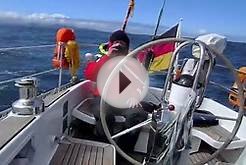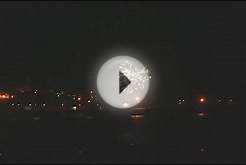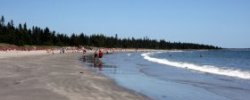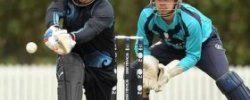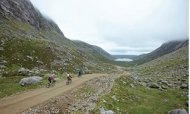 Descending to Loch Raonasgail, Isle of Lewis, on the Hebridean Trail. Click on the magnifying glass icon to see the route. Photographs: Lukasz Warzecha
Descending to Loch Raonasgail, Isle of Lewis, on the Hebridean Trail. Click on the magnifying glass icon to see the route. Photographs: Lukasz Warzecha
"The best way to ride over babies' heads is in a low gear, " says Sue. "Give it a bit of brake too, just to be sure you hit them right." With that advice she's off, a blur of neon pink Gore-Tex pedalling hungrily up the ancient Coffin Road.
As far as the UK – or even western Europe – goes, the Outer Hebrides is pretty much as far off the beaten track as it gets. So where better to rediscover the joys of mountain biking? This was my first time back in the saddle since riding to and from school across a few gentle hills some 15 years ago. And here, at the bottom of the Isle of Harris's unforgiving, precipitous Coffin Road, it was very much a case of back in at the steep end.
I'd flown from Inverness to the island of Benbecula, at the southern end of this rugged, wind-washed archipelago, to be one of the first to experience the new Hebridean Trail. Created by adventure travel company Wilderness Scotland and cycle specialist Saddle Skedaddle, it's a 175-mile route linking seven of the larger Hebridean islands.
I'd expected five days of lung-stretching physical exertion. What I hadn't counted on was a series of equally breath-snatching vistas: spectacular mountains, expansive seascapes and near-endless white beaches that could just as easily have been in the Caribbean as hidden away on a remote chain of Scottish islands.
There's a saying out here in the Western Isles: "When God made time, he made plenty of it." And that describes the pace of life here rather well. Flying over in a tiny plane feels not just like crossing The Minch – the stretch of Atlantic separating the Outer Hebrides from mainland Scotland – but also like a wrinkle in time. These hardy outposts of peat and basalt – huddled together in a waning crescent against whatever the Atlantic can throw at them – are just 600 miles from my home in London, but they may as well be 6, 000 miles away.
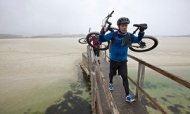 On landing, I discover there are no taxis at the airport and no regular buses to my hotel, which lies across a distant causeway on the neighbouring island of South Uist.
On landing, I discover there are no taxis at the airport and no regular buses to my hotel, which lies across a distant causeway on the neighbouring island of South Uist.
"Don't worry, " says the lady who makes the tea in the arrivals/departures/baggage lounge. "The Post Office van will take you."
Half an hour later, I'm helping the local post lady, Morag, with her round – bouncing alongside her in the battered red van like a cross between Marty McFly and Jess the Cat.
As we drive across the loch-dotted landscape, locals get into and out of the back of the van like human parcels, delivering themselves en route. They chat to each other in their first language, Gaelic, with a few English words – "carpet"… "loony"… "90-odd quid" – popping up within the lilting like remote Atlantic islands.
The group – eight riders and two guides – encompasses pretty much every demographic in the UK; men and women ranging from early thirties to early seventies, from the south coast of England to the Highlands of Scotland.
The following morning, we each pull on leggings, padded cycling shorts, windproof jackets and helmets for the first leg of our journey. Tony, one of the guides, takes us through the day's route on a map: over 50 miles, we'll push up through the coastal flower meadows – or "machair" – of South Uist and Benbecula, crossing causeways until we reach our evening destination – the village of Lochmaddy on the island of North Uist.
The organisation of this trip, run by Wilderness Scotland, makes things as easy as riding in Bradley Wiggins' slipstream. Each day, one of the guides leads the ride, while the other drives the big support van, containing luggage, food and spare parts. Every few hours, the van catches up with us and we refuel, look after any repairs and discuss the next stage. It's like being part of a road racing team – but with fewer roads.
Jonathan Thompson after a 2km beach cycleOn that first day, we pedal past croft houses and ancient stone ruins, across raw, deserted beaches and over narrow inter-island causeways warning us to remain vigilant for "Otters Crossing". Most of the signposts are in Gaelic, but it swiftly becomes apparent that there's a second language here I don't understand either: mountain biker.
With the help of Tim and Sue, a couple of bicycle fanatics from Yorkshire, I learn the basics: "single track" (narrow trails, not music); "eggbeaters" (pedals, not food preparation) and "snakebites" (punctures, not a mistake at the bar).
Meanwhile, "babies heads", I learn, are tiny boulders that can easily result in snakebites or, if you're particularly unlucky, detach you from your eggbeaters and send you flying off the single track.
Around 5pm we finally swoop down into Lochmaddy to observe what will become a daily ritual: post-pedal pints. There's something decidedly après-ski about proceedings, from the bar invasion in clompy footwear and technical layers, to the friendly teasing and aching hamstrings.
On day two, after fuelling up on bacon and haggis sandwiches for breakfast, we catch the ferry to Leverburgh on the mountainous Isle of Harris, tweed capital of the world.
Harris is so unlike the lower islands in the chain that it feels as if we've arrived in an entirely different country. Whereas the Uists and Benbecula are low-lying patchworks of land and water, Harris (the old Norse word for "higher") is rocky, raw and tall, with a number of world-class beaches set against a magnificent Atlantic backdrop along its western Gold Coast.
Inevitably, we face more challenging gradients here – including the island's mountainous, zigzagging Coffin Road. The locals used to process their dead along this route – from the crofts on the east of Harris to the burial grounds of the west – and cairn clusters are still in evidence, constructed to keep the deceased safe while the living rested. After an hour on the trail, I have the utmost respect for those long-forgotten undertakers. It's difficult enough to climb this route with a full-suspension mountain bike on a summer's day. I cannot imagine what it must have been like during a Hebridean winter, shouldering a heavy coffin.
Sweating, panting and constantly shifting gear like a group of nervous drug mules at an airport, we finally make it to the top.
It's while riding over Harris that I notice a change in myself: I've stopped looking out for the support van. In fact, I start to feel disappointed whenever it appears, because it means I have to stop riding. My legs certainly feel stronger, but there's something else too: the elemental beauty of this place has – for want of a better word – bewitched me. It's as if the clear, translucent air is rinsing away the psychological smog of the big city. And even though I probably reek of sweaty Lycra, I feel pristine – outside and in.

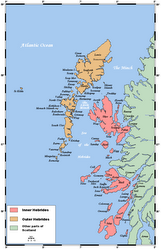 The Hebrides ( /ˈhɛbrɨdiːz/; Scottish Gaelic: Innse Gall) comprise a widespread and diverse archipelago off the west coast of Scotland. There are two main groups: the Inner and Outer Hebrides. These islands have a long history of occupation dating back to the...
The Hebrides ( /ˈhɛbrɨdiːz/; Scottish Gaelic: Innse Gall) comprise a widespread and diverse archipelago off the west coast of Scotland. There are two main groups: the Inner and Outer Hebrides. These islands have a long history of occupation dating back to the...
